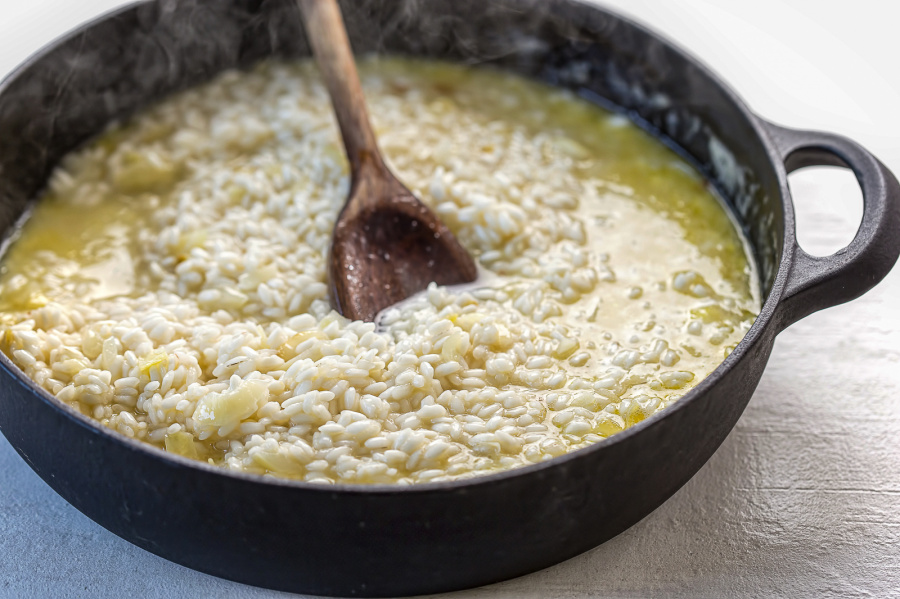
7 Tips for Making an Excellent Vegan Risotto
Risotto comes from the Italian word for ‘rice’ (‘riso’). It has an augmenting suffix ‘-tto’ added that makes the word ‘Risotto’ literally mean ‘big rice.’ And big rice is a perfect description of this famed Italian dish that delivers big flavors, creamy nourishment and total satisfaction.
But cooks often make risotto incorrectly and it turns into a gruel, swimming in way too much butter and cheese. Vegan cooks strip away the butter and cheese but that often leads to a flat tasting and dry rice dish without character. Both are common mistakes…and both are not a true risotto.
Italian risotto
Subscription Required For This Content
Risotto comes from the Italian word for ‘rice’ (‘riso’). It has an augmenting suffix ‘-tto’ added that makes the word ‘Risotto’ literally mean ‘big rice.’ And big rice is a perfect description of this famed Italian dish that delivers big flavors, creamy nourishment and total satisfaction.
But cooks often make risotto incorrectly and it turns into a gruel, swimming in way too much butter and cheese. Vegan cooks strip away the butter and cheese but that often leads to a flat tasting and dry rice dish without character. Both are common mistakes…and both are not a true risotto.
Italian risotto is made with medium-grain specialty rice varieties that are rich in starch. The entire idea of a risotto is to cook the rice in a flavorsome broth while allowing the starch from the rice to slowly release.
The cooking liquid is added to the rice in small amounts in an open pan over medium-high heat. This causes much of the moisture to evaporate, meaning over time, the cooking liquid’s flavor concentrates in the dish and thickens into a creamy consistency as the starch is released from the rice. This is the secret of making a good risotto…and it’s not simple.
Here are seven of my tips for making an excellent vegan risotto:
- Different risotto rice varieties yield different results: Arborio cooks in about 17-19 minutes and has the most starch. Carnaroli cooks in 15-17 minutes and has a moderate amount of starch. Vialone Nano cooks the quickest –13-15 minutes but has the least amount of starch, so the finished risotto won’t be as creamy.
- Make sure to use a flavorful broth for any risotto you are making. Try to flavor the broth to highlight the main ingredient. For example, when making a mushroom broth, use rehydrated dried mushrooms and strain the liquid carefully into your vegetable broth. Use the rehydrated mushrooms later when combining with cooked mushrooms.
- Use a very acidic white wine for risotto. My usual choice is an Alsatian Riesling, although German varieties work just as well. Italian Sauvignon Blanc or Vermentino are other whites to consider.
- I add uncooked main ingredients to the rice after the wine has been added and just before adding the first round of stock. This ensures enough time to fully cook the ingredient without overcooking the rice. You can also cook the main ingredients separately and add them to the risotto about 8-10 minutes into the cooking process.
- Avoid constant stirring of the rice while it is cooking. A quick stir or mix is fine after each addition of the broth. This prevents the rice from sticking to the bottom of the pan. Constant stirring creates too much movement of the rice and causes the rice to break or separate easily because the starches expand too fast.
- I add up to 2 tablespoons flaxseed-parmesan shaker with the nutritional yeast to create an extra creamy risotto. Be sure to leave more liquid in the rice if using this method because the ground flaxseeds will thicken the liquid.
- Always rest the finished risotto about 10 minutes before serving it – the best flavor comes out when the rice has cooled a bit and the starchy elements become creamy and slightly thicker. Don’t worry if the risotto becomes too thick at this point – just add some more broth to the rice and gently mix to create the right consistency.